A New Species of Freshwater Amphipods Echinogammarus (Amphipoda, Gammaridae) from Algeria
Abstract
1. Introduction
2. Material and Methods
2.1. Study Sites
2.2. Animal Sampling and Preparation
3. Results
3.1. Systematic Part
3.2. Material Examined
3.3. Type Locality
3.4. Etymology
3.5. Description
3.6. Sexual Dimorphism
3.7. Remarks and Affinity
3.8. Distribution and Ecology
4. Discussion
5. Conclusions
Author Contributions
Funding
Acknowledgments
Conflicts of Interest
References
- Väinölä, R.; Witt, J.D.S.; Grabowski, M.; Bradbury, J.H.; Jazdzewski, K.; Sket, B. Global diversity of amphipods (Amphipoda; Crustacea) in freshwater. Hydrobiologia 2008, 595, 241–255. [Google Scholar] [CrossRef]
- Rewicz, T.; Rachalewski, M.; Grabowski, M. First record of Echinogammarus pungens (H. Milne Edwards, 1840)(Crustacea, Amphipoda) from Africa with the checklist of North African freshwater gammarids. Medit. Mar. Sci. 2014, 15, 443–448. [Google Scholar] [CrossRef]
- Ayati, K.; Hadjab, R.; Khammar, H.; Dhaouadi, S.; Piscart, C.; Mahmoudi, E. Origin, diversity and distribution of freshwater epigean amphipods in Maghreb. Ann. Limnol.-Int. J. Limnol. 2019, 55, 13. [Google Scholar] [CrossRef]
- Ayati, K.; Dhaouadi, S.; Piscart, C.; Mahmoudi, E. Diversity and distribution of freshwater amphipods from Tunisia. Biodiv. J. 2017, 8, 431–432. [Google Scholar]
- Ayati, K.; Dhaouadi, S.; Mahmoudi, E.; Piscart, C. Two New Species of Gammarid Amphipods from Tunisian Fresh Waters (amphipoda, Gammaridae). Crustaceana 2018, 91, 1327–1345. [Google Scholar] [CrossRef]
- Pinkster, S. A revision of the genus Echinogammarus Stebbing, 1899, with some notes on related genera (Crustacea, Amphipoda). Mem. Museo Civ. Stor. Nat. 1993, 10, 1–185. [Google Scholar]
- Piscart, C.; Merzoug, D.; Hafid, H. A new species of Echinogammarus from Algerian fresh waters, Echinogammarus haraktis n. sp. (Peracarida, Amphipoda). Crustaceana 2013, 86, 1623–1633. [Google Scholar] [CrossRef]
- Coleman, C.O. “Digital inking”: How to make perfect line drawings on computers. Org. Divers. Evol. 2003, 3, 303–304. [Google Scholar] [CrossRef]
- Pinkster, S.; Stock, J.H. Members of the Echinogammarus simoni-group and the genus Eulimnogammarus (Crustacea – Amphipoda) from the Iberian Peninsula and North Africa, with description of a new species. Bull. Zool. Mus. 1972, 2, 85–99. [Google Scholar]
- Pinkster, S. The Echinogammarus berilloni-group, a number of predominantly Iberian Amphipod species (Crustacea). Bijdr. Dierkd. 1969, 43, 1–36. [Google Scholar] [CrossRef]
- Stock, J.H. A revision of the European species of the Echinogammarus pungens-group (Crustacea, Amphipoda). Beaufortia 1968, 16, 13–78. [Google Scholar]
- Fadil, F.; Dakki, M. A new species of Echinogammarus Stebbing, 1899 (Crustacea, Amphipoda) from Moroccan freshwaters. Beaufortia 2003, 53, 53–59. [Google Scholar]
- Özbek, M.; Ustaoğlu, M.R. Echinogammarus baliki, a new species of amphipod from Turkey (Amphipoda, Gammaridae). Crustaceana 2007, 80, 1043–1055. [Google Scholar] [CrossRef]
- Grintsov, V. A New Amphipod Species Echinogammarus karadagiensis sp. n. (Amphipoda, Gammaridae) from Crimean Coasts (Black Sea). Vestnik Zool. 2009, 43, e-23–e-26. [Google Scholar] [CrossRef]
- Hou, Z.; Sket, B. A review of Gammaridae (Crustacea: Amphipoda): The family extent, its evolutionary history, and taxonomic redefinition of genera. Zool. J. Linn. Soc. Lond. 2016, 176, 323–348. [Google Scholar] [CrossRef]
- Sket, B.; Hou, Z. Family Gammaridae (Crustacea: Amphipoda), mainly its Echinogammarus clade in SW Europe. Further elucidation of its phylogeny and taxonomy. Acta Biol. Slov. 2018, 61, 93–102. [Google Scholar]
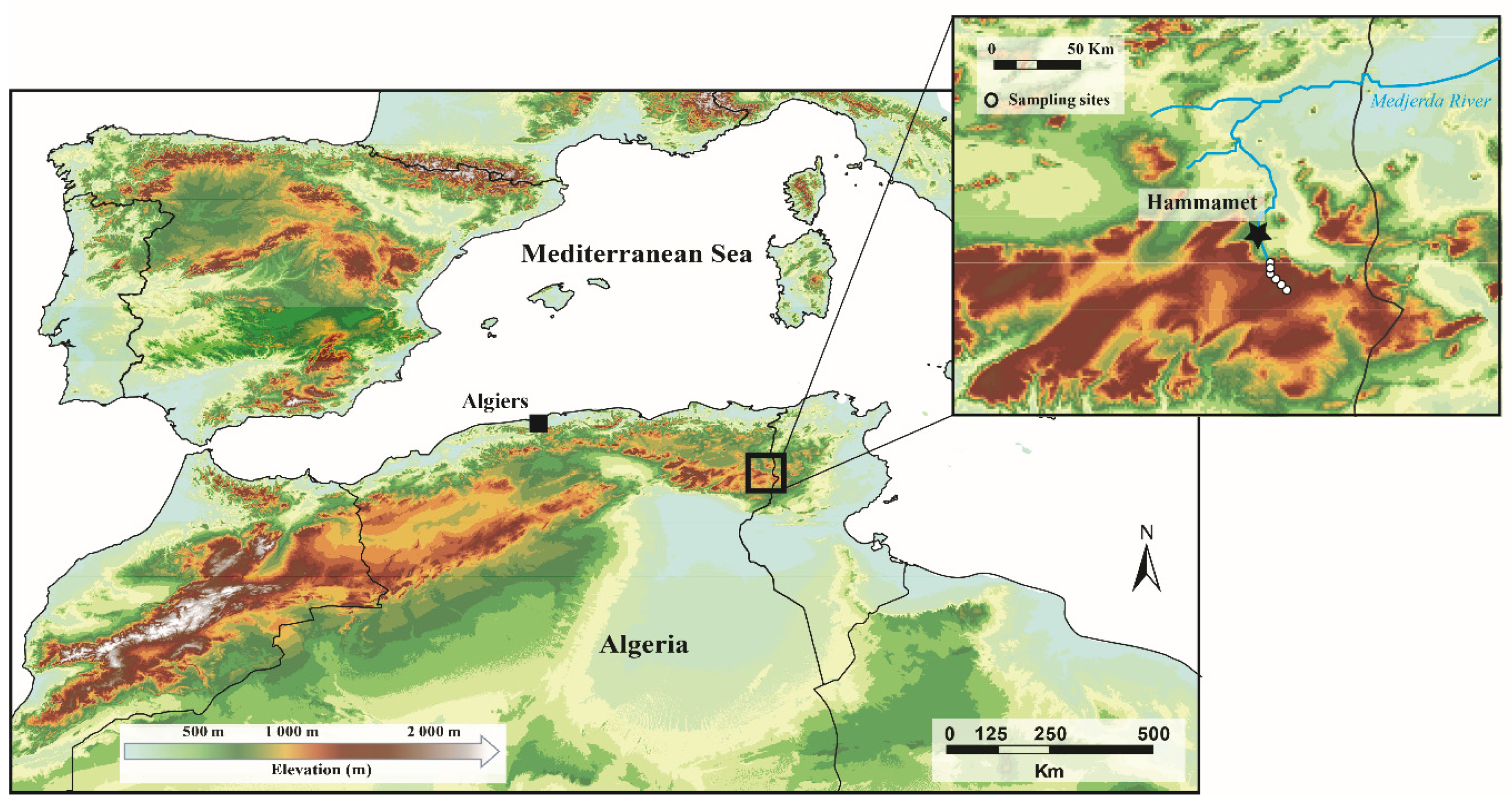
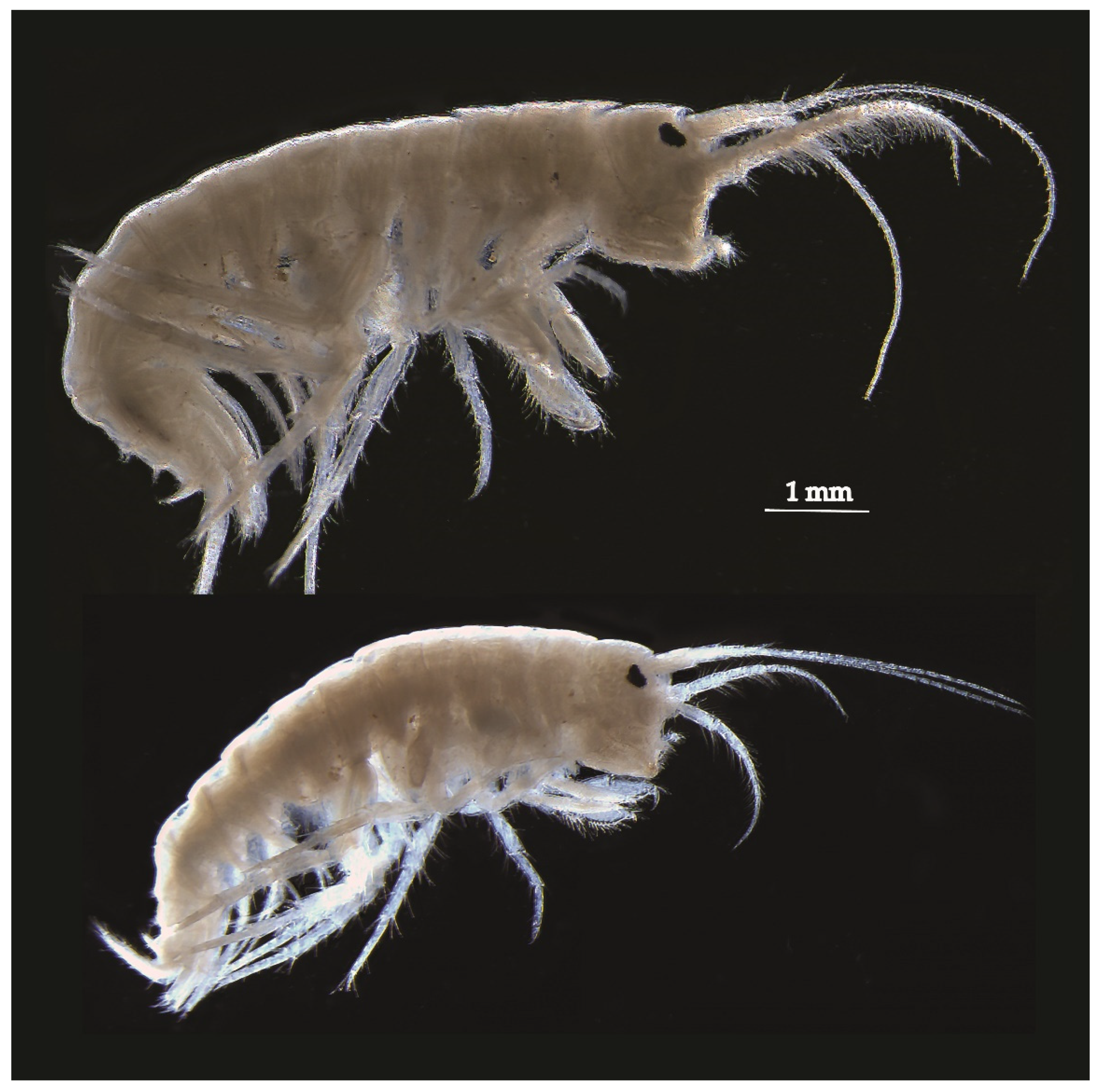
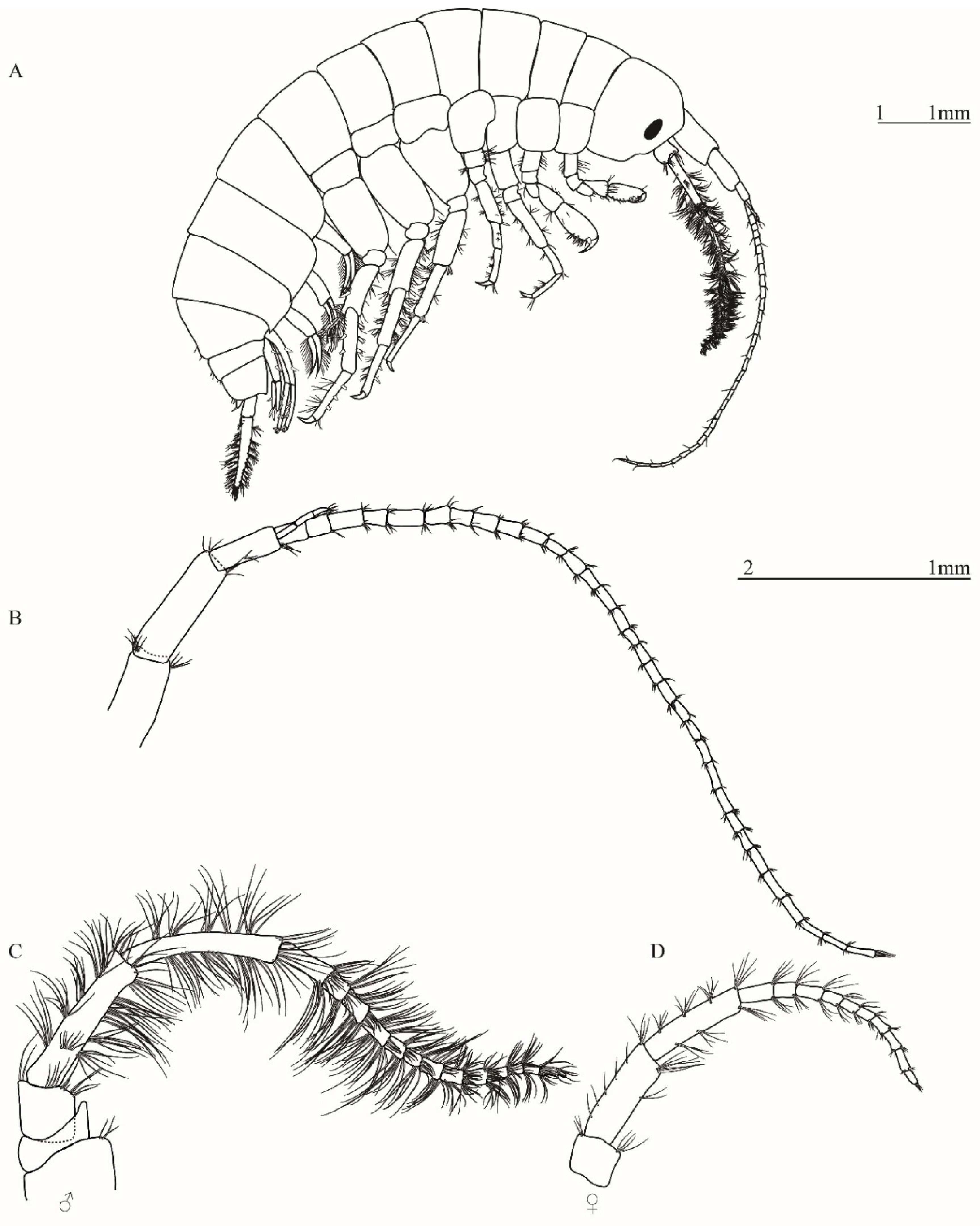


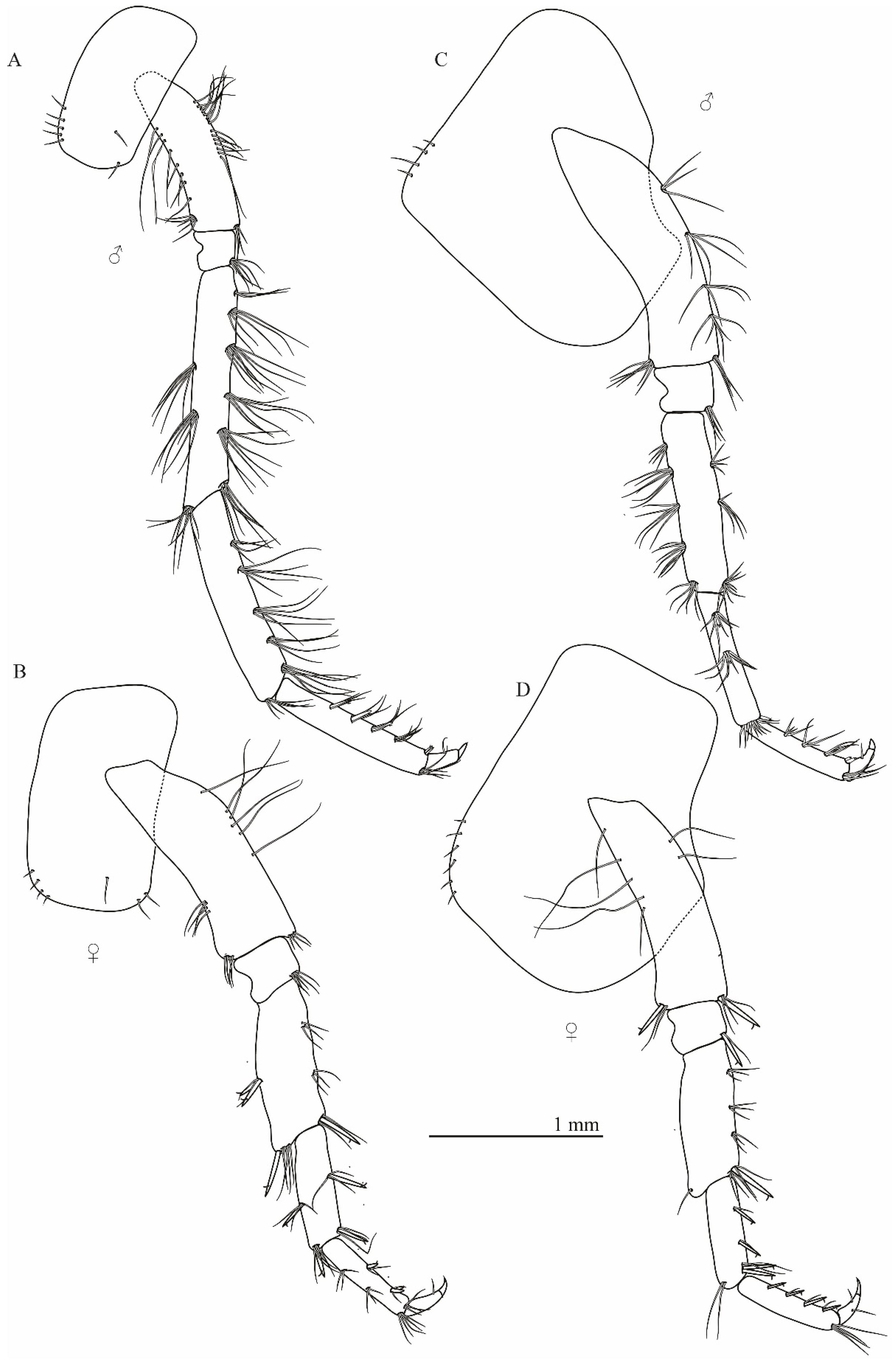

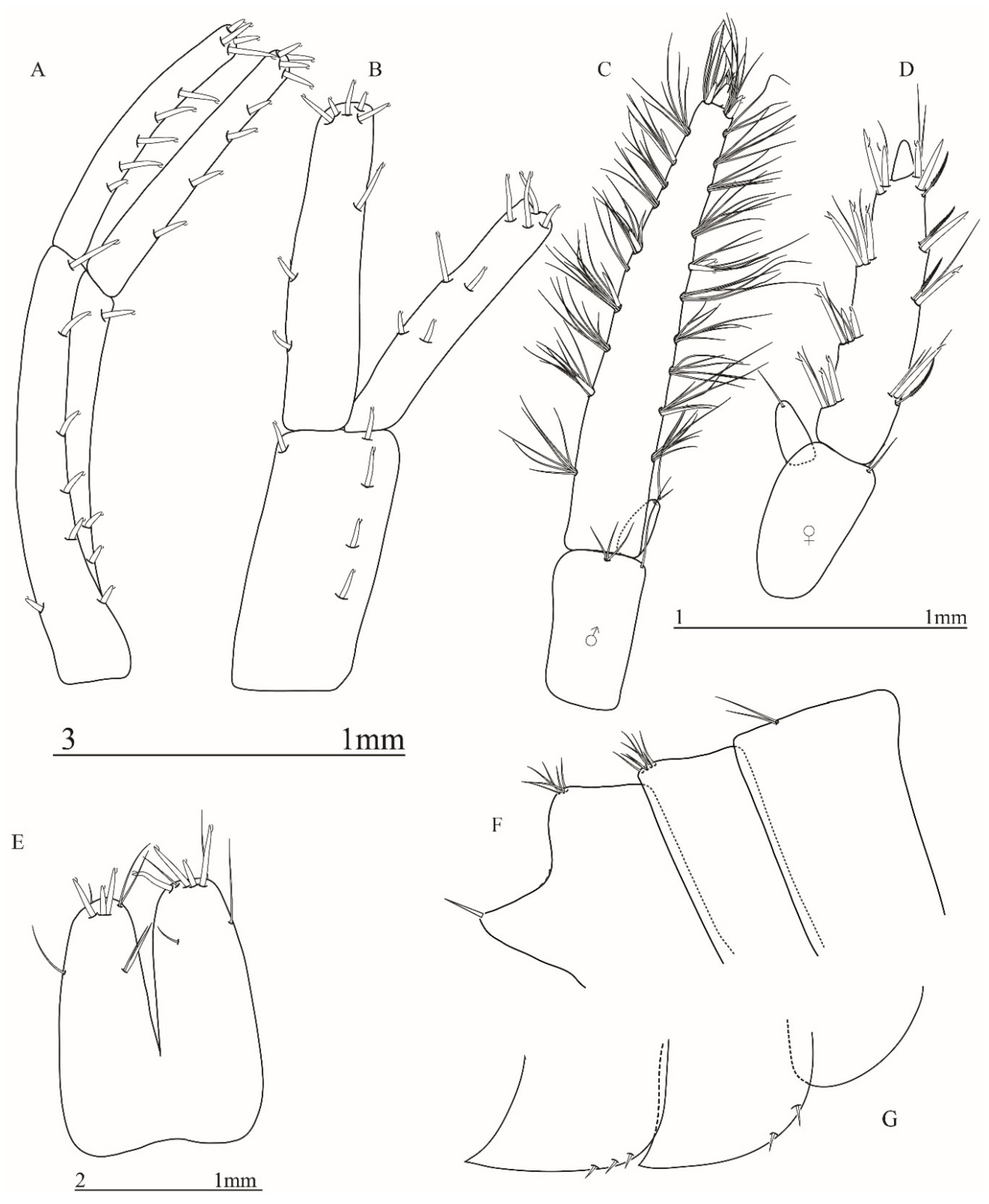
| Morphological Characteristics | E. monodi | E. berilloni Group | E. pungens Group | E. simoni Group |
|---|---|---|---|---|
| - Eyes large, elongated | X | X | ||
| - Eyes small, rounded | X | X | ||
| - Gnathopod 2 propod larger than those of gnathopod 1 | X | |||
| - Gnathopod 2 carpus elongated | X | X | ||
| - Pereopods 5–7 with groups of long setae | X | X | ||
| - Metasome with teethlike projections | X | |||
| - Metasome with dense spinulation | X | |||
| - The presence of compressed dorsal elevations on the urosome | X | |||
| - Epimeron with long setae in ventral margin | X | X |
| Mean Values (Min–Max) | |
|---|---|
| Temperature (°C) | 15.5 (15.3–15.8) |
| pH | 7.5 (7.4–7.6) |
| Electrical conductivity (µSm.cm−1) | 389 (359–445) |
| NH4+ (mg.L−1) | 0.2 (0.2–0.3) |
| NO3− (mg.L−1) | 3.3 (2–4) |
| NO2− (mg.L−1) | 0.1 (0.1–0.2) |
| PO42− (mg.L−1) | 0.8 (0.7–1) |
| H2SiO42− (mg.L−1) | 23.7 (18.5–28) |
| Ca2+ (mg.L−1) | 69.6 (67–73.6) |
| Mg2+ (mg.L−1) | 15.4 (13.9–16.9) |
| Cl− (mg.L−1) | 115 (109–134) |
Publisher’s Note: MDPI stays neutral with regard to jurisdictional claims in published maps and institutional affiliations. |
© 2020 by the authors. Licensee MDPI, Basel, Switzerland. This article is an open access article distributed under the terms and conditions of the Creative Commons Attribution (CC BY) license (http://creativecommons.org/licenses/by/4.0/).
Share and Cite
Hadjab, R.; Ayati, K.; Piscart, C. A New Species of Freshwater Amphipods Echinogammarus (Amphipoda, Gammaridae) from Algeria. Taxonomy 2021, 1, 36-47. https://doi.org/10.3390/taxonomy1010005
Hadjab R, Ayati K, Piscart C. A New Species of Freshwater Amphipods Echinogammarus (Amphipoda, Gammaridae) from Algeria. Taxonomy. 2021; 1(1):36-47. https://doi.org/10.3390/taxonomy1010005
Chicago/Turabian StyleHadjab, Ramzi, Khaoula Ayati, and Christophe Piscart. 2021. "A New Species of Freshwater Amphipods Echinogammarus (Amphipoda, Gammaridae) from Algeria" Taxonomy 1, no. 1: 36-47. https://doi.org/10.3390/taxonomy1010005
APA StyleHadjab, R., Ayati, K., & Piscart, C. (2021). A New Species of Freshwater Amphipods Echinogammarus (Amphipoda, Gammaridae) from Algeria. Taxonomy, 1(1), 36-47. https://doi.org/10.3390/taxonomy1010005






